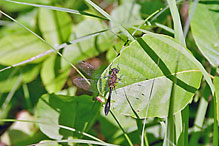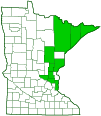mustached clubtail
(Hylogomphus adelphus)
Conservation • Description • Habitat • Ecology • Distribution • Taxonomy
|
|
|||||||||||||
Description |
The face is yellow. The upper part of the face (frons) is completely surrounded with a bold black border. The bottom of the border forms a black “mustache” line across the face that gives this species its common name. There is also a wider horizontal stripe on the lower part of the face above the upper lip (labrum), and an inverted triangle dividing the labrum. |
Size |
Total length: 1 11 ⁄16″ to 1 13 ⁄16″ |
Similar Species |
Habitat |
Fast-flowing streams and rivers, exposed lake shores |
Ecology |
Season |
Early May to late August |
Behavior |
|
Life Cycle |
|
Larva Food |
|
Adult Food |
|
Distribution |
||
|
Sources Haarstad, J. 1997. The dragonflies of selected eastern Minnesota rivers. Report submitted to the Minnesota Department of Natural Resources. Unpaged. |
|
| 6/24/2025 | ||
Occurrence |
||
|
||
Taxonomy |
|
Order |
Odonata (Dragonflies and Damselflies) |
Suborder |
|
Superfamily |
Gomphoidea |
Family |
Gomphidae (clubtails) |
Genus |
Hylogomphus |
|
|
Superfamily Genus |
|
Subordinate Taxa |
|
|
|
Synonyms |
|
Gomphus adelphus Gomphus brevis Hylogomphus brevis |
|
Common Names |
|
mustached clubtail |
|
Glossary
Frons
The upper front part of an insect’s face, roughly corresponding to the forehead.
Labrum
The upper part of the mouth, sometimes considered the lower part of the face, corresponding to the upper lip, on an insect or crustacean.
Visitor Photos |
||
Share your photo of this insect. |
||
This button not working for you? |
||
|
||
MinnesotaSeasons.com Photos |
||

Slideshows |
|

Visitor Videos |
||
Share your video of this insect. |
||
This button not working for you? |
||
|
Other Videos |
||
|

Visitor Sightings |
||
Report a sighting of this insect. |
||
This button not working for you? |
||
|
|
MinnesotaSeasons.com Sightings |
||

Created: 6/26/2005 Last Updated: © MinnesotaSeasons.com. All rights reserved. |

